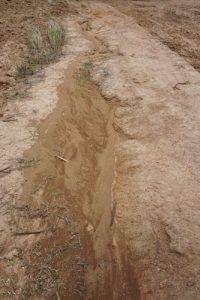Lasers are a part of the technology that is used to study the movement of water through soil; a technique called soil hydrology. Through this study, soil scientists can more accurately predict water flow. Recently, researchers at the University of Kansas used a multi-stripe laser triangulation (MLT) scanner to help them quantify the macropores in soil around an excavated area. The scanner helped to show how the pore size in the soil could predict preferential flows of water.
Significant portions of water are transported through a small number of large soil pores. This means
that a soil pore that is two times as large as another is able to conduct sixteen times the volume of water as compared to a smaller soil pore. This is referred to as preferential flow.
In order to determine if the MLT scanner could accurately determine the preferential flow, the researchers worked with saturated soil, put a blue dye into the sample and followed its flow. They discovered an easy to identify visible patterns as a result of the test; areas of the soil that turned blue had larger pores. The larger pores allowed the dye to pass through and demonstrated a preferential flow pattern that the scientists were able to note.
The next test was with the same soil sample being scanned with the MLT and it highlighted that the laser was able to significantly match the patterns the dye had followed. The scanner detected and allowed for mapping of the soil’s macroporosity in saturated versus dry soil.
Using custom laser lenses in the further study of soil hydrology could lead to more efficient use of water for food production. It could also benefit drought-ridden areas in the management of water resources. The MLT technology may also help scientists anticipate and implement plans to reroute water runoff and help eliminate soil erosion.
Universe Kogaku designs and manufactures optical lenses for scientific use like soil hydrology. We also design and carry lenses and lens assemblies for industrial, medical, high tech, electronic applications as well as for scanners, CCTV, CCD/CMOS, surveillance systems, machine vision and night vision systems.